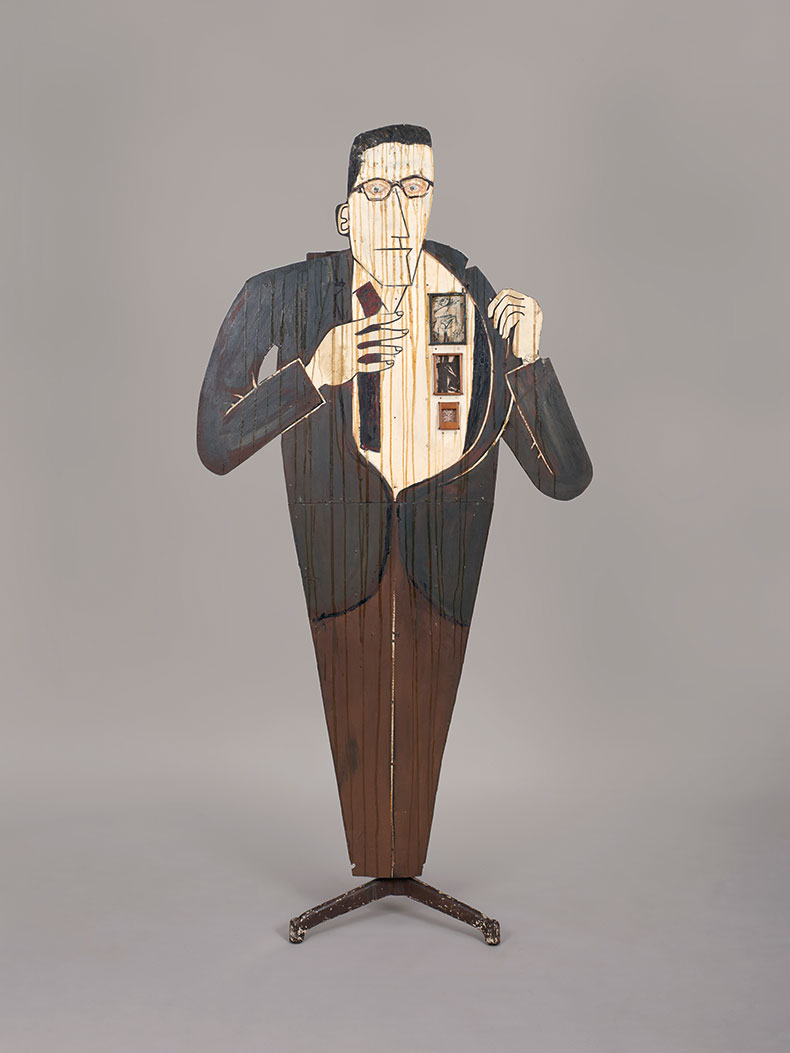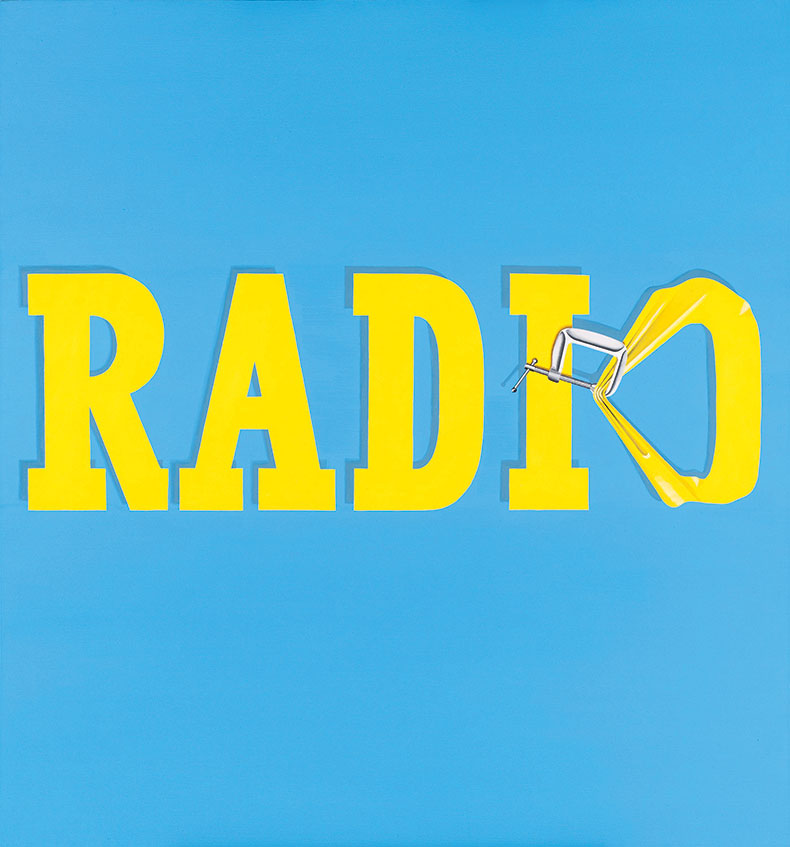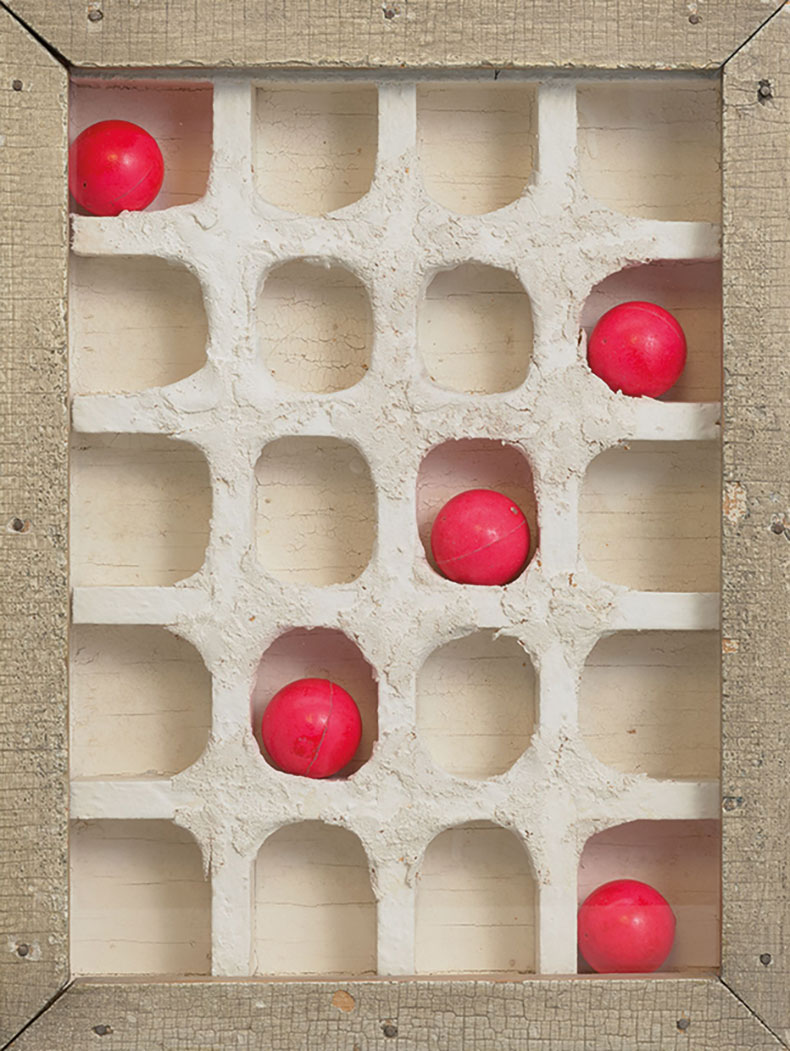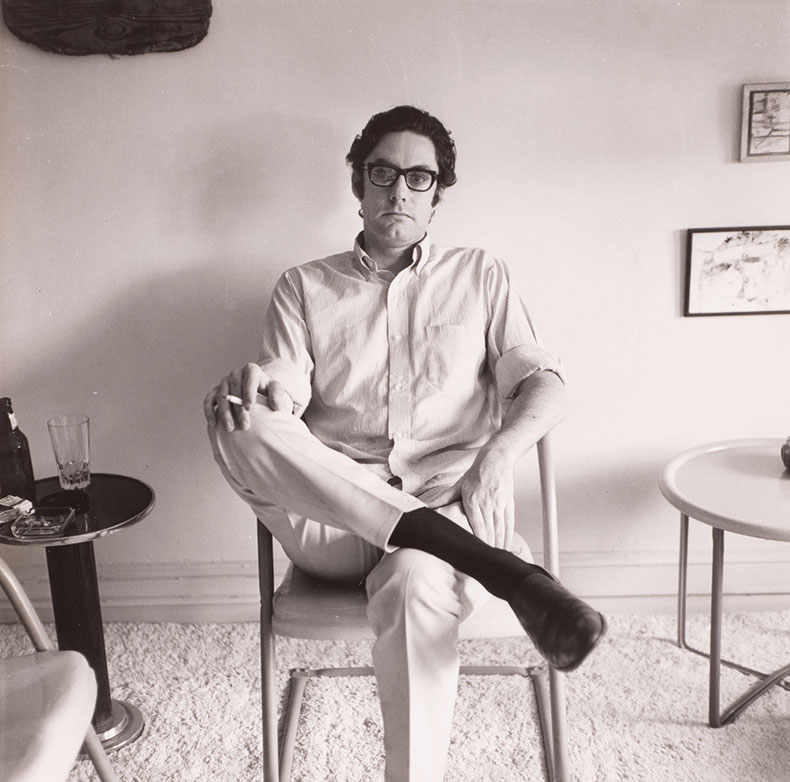From the May 2023 issue of Apollo. Preview and subscribe here.
In 1959, the sculptor Ed Kienholz made a work based on his friend Walter Hopps. Though Hopps was only 27 years old at the time, he and Kienholz had already known each other for four years, ever since Kienholz wandered into Hopps’s first gallery, Syndell Studio, on the west side of Los Angeles. In 1956, Hopps gave Kienholz his first show. The following year, they decided to open a gallery together, which they called Ferus.
The gallery was quickly a success among the city’s wild and woolly Beat avant-garde, although as Hopps later recalled in his memoir, ‘Astoundingly little art was sold.’ After two years, Hopps told Kienholz that he wanted to buy him out. Kienholz wasn’t interested in commerce, he argued, and ought to devote himself fully to his own art. Kienholz grudgingly accepted.
Kienholz’s sculpture, titled Walter Hopps Hopps Hopps, incorporates the many sides of his mercurial and often maddening comrade. The piece was based on a figure familiar to many in the 1950s: the Bardahl Man, a character invented to sell motor oil. Kienholz’s freestanding painted wooden cut-out, modified to look like Hopps (glasses, slimline suit, no hat), reveals inside his jacket not motor oil, but miniature paintings, reproductions of works by Willem de Kooning, Franz Kline, and Jackson Pollock (all artists based in New York).
Walter Hopps Hopps Hopps (1959), Edward Kienholz. Menil Collection, Houston. Photo: Caroline Philippone; courtesy LA Louver; © Estate of Edward Kienholz

The irony Kienholz intended was that Ferus was set up to champion West Coast artists, who had scant opportunity to show theirwork in Los Angeles at that time. Its inaugural show included John Altoon, Jay DeFeo, Richard Diebenkorn, Sonia Gechtoff, Craig Kauffman, Frank Lobdell and Clyfford Still (who had moved back to New York from San Francisco in 1950). Kienholz teased Hopps that he held the work of the Ab-Ex titans in higher regard than he did the artists on his doorstep. Hopps countered that Kienholz didn’t want to show his own work at Ferus either. (In 1960, he succeeded in talking Kienholz into an exhibition, for which he installed Walter Hopps Hopps Hopps in the gallery window.)
In the portrait, Hopps’s eyes are bloodshot, his wristwatch reads ‘LATE’, and he appears to be sweating shellac, which runs down his shirt. The back of the sculpture is where the gloves really come off, though. Kienholz built small compartments into the figure bearing labels such as ‘important people with influence or money’ and ‘competitors and other types’. He persuaded Hopps to write out lists in his own hand (Hopps loved lists) featuring artists’ names, satirically misspelled, such as ‘William de Conning’ and ‘Franz Climb’. There is even a secret compartment, accessible only with a screwdriver, containing a stash of drugs – uppers and downers – ‘some that I used, and some that I didn’t use,’ Hopps later said. At the time, and for years after, he was getting by on about four hours of sleep a night.
This sculpture greets visitors to ‘The Curatorial Imagination of Walter Hopps’ at the Menil Collection, Houston (until 13 August), the institution of which Hopps became the founding director when it opened in 1987. The exhibition draws in large part from a promised gift to the museum of more than 500 works from the collection of Hopps and his widow, Caroline Huber, whom he married in 1983.
Between the founding of Syndell Studios in the early 1950s and his death at the age of 72 in 2005, Hopps enjoyed a stellar career: in 1964, at the Pasadena Art Museum (now the Norton Simon), he became the youngest museum director in America; a year later he commissioned the US contribution to the São Paulo Biennial; in 1972 he was the commissioner for the US pavilion at the Venice Biennale. When Dominique de Menil began planning a museum to house her unparalleled collection in 1980, she enlisted Hopps, who took up temporary residence in a bedroom of her Philip Johnson-designed Houston villa.
By and large, since (and maybe even during) his lifetime, Hopps has remained mostly a cipher, defined by often repeated legends of his eccentricities, or by the artists he championed, or the scenes he moved through. There’s the story of the lapel badge worn by staff at the Corcoran Gallery of Art in Washington, D.C., which he ran between 1969 and 1971: ‘Walter Hopps Will Be Here in 20 Minutes’ it read, in exasperated acceptance of his pathological lateness. Or the tale of his precocious friendship with Walter and Louise Arensberg, when he was just a teenager and they were the most distinguished collectors of modern art on the West Coast. Or anecdotes about his atrocious driving style, his nocturnal work schedule, his prodigious memory, his knack for getting fired, or his seemingly boundless, often-narcotised, energy levels. But what of Hopps’s vision? Even ‘The Curatorial Imagination of Walter Hopps’ can provide only oblique insights.
Hurting the Word Radio #1 (1964), Edward Ruscha. Menil Collection, Houston. Photo: Paul Hester; © Edward Ruscha

Hopps, like most curators, was an aggressive aggregator, who was able to survey the landscape of contemporary art-making and plot routes through it. He covered so much ground that it was not always easy to see where he wanted to go. Did he follow contemporary culture, or lead it? During his Los Angeles years, he championed several seemingly opposed artistic camps, among them the lyrical abstraction of painters like Diebenkorn, Hassel Smith and Sam Francis; the Beat-inspired, ragged mysticism of assemblagists such as Wallace Berman, George Herms and Ed Kienholz; and the East-Coast-influenced, steely-eyed conceptualism and minimalism of Billy Al Bengston, Ed Ruscha, Robert Irwin, Larry Bell and others, which emerged in the 1960s. Rivalries between these micro-tribes could be fierce; Hopps revealed to Calvin Tomkins that Irwin once ‘very nearly beat me up’ for extolling the achievements of Diebenkorn. Irwin yelled: ‘If you really feel like that, everything you’ve said about my work is a lie!’
When Hopps curated the US pavilion in Venice, he brought together abstract painters, Sam Gilliam and Ronald Davis, the Photorealist Richard Estes, the Chicago Imagist Jim Nutt, the photographer Diane Arbus and the video artist Keith Sonnier. The New York Times critic, Hilton Kramer, observed that such a miscellany, to Europeans, must be ‘baffling’. But he quotes Hopps, who argued that ‘to look for a single direction or a primary formal change by which to characterize contemporary art in the United States would be to miss its essential character’.
Clare Elliott, curator of ‘The Curatorial Imagination of Walter Hopps’ points to Hopps’s scientific background (born into a family of doctors, he studied microbiology alongside art history under the pretext that he might pursue medicine). ‘He has this scientific idea about art,’ Elliott says, ‘where he’s collecting data points, and then making connections, and making judgments, rather than coming to the art with some theory already in mind and picking out only things that fit into his theory.’
It makes sense that the artists that mattered most to Hopps were those who also gathered pre-existing data points, usually in the form of found objects rescued from the flotsam and jetsam of contemporary culture. Kienholz, Kurt Schwitters, Joseph Cornell, Wallace Berman and Robert Rauschenberg all shone brightly in Hopps’s firmament, but their pole star was Marcel Duchamp, whose first retrospective Hopps organised in 1963 at the Pasadena Art Museum. Hopps had first encountered the artist as a teenager at the Arensbergs’, where Duchamp would often stay while in California. The Arensbergs owned many works by Duchamp, including three versions of Nude Descending a Staircase; by the 1960s these pieces were ensconced in the collection of the Philadelphia Museum of Art, but Duchamp helped Hopps secure loans from all periods of his career.
Though Duchamp was almost 50 years older than Hopps, the two men shared a tendency to conceal their deep nonconformity beneath conformist trappings; both adopted a uniform of suit and tie to allow them to move inconspicuously among the establishment. The notorious photograph taken in Pasadena, showing a suited Duchamp playing chess against a naked young woman – the writer Eve Babitz, a sometime girlfriend of Hopps – illustrates this paradox of appearances. (While the picture was the idea of photographer Julian Wasser, and Hopps was reportedly shocked by it, it also speaks volumes about the boys’-club atmosphere of the art scene in Los Angeles at that time.)
Hopps’s other major exhibition from this period did not include actual found objects, but instead represented them. ‘New Painting of Common Objects’, which he staged at the Pasadena Museum a few months before the Duchamp retrospective, is often credited as being the first exhibition to identify the North American strain of Pop art, even before the term was widely used in the United States. (Hopps did not use the term in relation to his show.) It featured a large graphic painting of a tin of spam, Actual Size (1962), by the 24-year-old Ed Ruscha, who would go on to be perhaps the most famous of the Ferus artists, and another of hairspray, by Roy Lichtenstein, and two of soup cans by Andy Warhol, then mainly known as a commercial illustrator. Other artists, such as Robert Dowd and Phillip Hefferton, who both made paintings based on the design of dollar bills, are less-well known today.
Big Campbell’s Soup Can, 19¢ (Beef Noodle) Andy Warhol. Menil Collection, Houston. Photo: © Caroline Philippone; © 2023 The Andy Warhol Foundation for the Visual Arts, Inc./Artists Rights Society (ARS), New York

The show was undoubtedly informed by Hopps’s recent interest in the work of Warhol, whom he’d met in New York with his new partner at Ferus, Irving Blum. With the gallery in financial peril, Hopps went on the lookout for someone more adept at sales than the gruff and recalcitrant Kienholz. Blum was a smooth-talking former actor who had worked as an art advisor for the Knoll furniture company; in 1959, Hopps invited him to take over Kienholz’s share of the gallery. Blum’s artistic purview tilted eastwards, rather than towards California – a tendency over which he and Hopps often clashed, but which invigorated Ferus (and many of its artists) with the arrival of Warhol’s brand of American Pop.
In July 1962, just two months before ‘New Painting of Common Objects’, the Ferus gallery presented Warhol’s series Campbell’s Soup Cans (1962), each painting depicting one of the 32 flavours. It was Warhol’s first significant solo exhibition. Each painting was priced at $100; so few sold that Hopps and Blum proposed to Warhol that they cancel the sales and keep the series together. They paid him $1,000 for it, which he happily accepted, and walled-in the paintings so they would not be tempted to sell them. When, shortly after, Hopps became director of the Pasadena Art Museum, he sold his share in Ferus – and his share of Campbell’s Soup Cans – back to Blum. In 1996, Blum negotiated a partial gift of the series to the Museum of Modern Art, which netted him $15 million.
Warhol, Hopps later reflected, ‘drained the juice out of any sort of existential engagement’. One gets the sense that he allows Warhol his importance somewhat grudgingly; even if he ‘opened the door to the postmodern generation’, as he says, Hopps’s own vision always seemed to lean more towards the surreal, the vernacular and the marginal. It’s evident in his admiration of the assemblage shadow boxes of Joseph Cornell, or his sustained attention to the documentary photography of William Christenberry, William Eggleston and Walker Evans, each with their particular vision of Americana. We see it in the charming surrealism of Ruscha more than the chilly serialism of Warhol. When Hopps’s eye was drawn toward the emergent Pictures Generation in the 1980s, he recognised the connective facilities of artists like Robert Longo, Gretchen Bender and Haim Steinbach – all of whom destabilised or reconstituted meanings between found images or objects.
Discarded Descartes (1954–56), Joseph Cornell. Menil Collection, Houston. Photo: Paul Hester; © The Joseph Cornell and Robert Cornell Memorial Foundation/VAGA at Artists Rights Society (ARS), New York

Hopps’s interests were as broad as they were deep. ‘While I was at Pasadena, I looked for every chance I could get to jury exhibitions in other parts of the country,’ Hopps wrote. ‘I liked to get out to the heartland […] and just see what was going on.’ He would also look around for things if he did not readily see them on the surface of contemporary culture. While at the Washington Gallery of Modern Art, in the 1970s, Hopps organised, on short order, an exhibition of figurative painting, in response to the overwhelming predominance at the time of abstraction. He and his somewhat sceptical aides scoured the art studios of Washington, D.C.; he titled the packed, salon-style show, ‘All Kinds of People’. In 1978, at the non-profit Museum of Temporary Art, also in Washington, D.C., he mounted a show called ‘36 Hours’ for which he accepted – and hung – all work delivered to the gallery by local artists within a 36-hour period.
Then there were the shows that never happened. He fought, unsuccessfully, to convince Lawrence Alloway, curator at the Guggenheim in the early 1960s, to let him put together an exhibition for the museum of 100 works by 100 artists, all from 1951 (‘a sort of zenith,’ he later said). Even more ambitious was his proposal for an exhibition of 100,000 photographs, ‘by every good photographer in the world who’s alive and working’, all stapled directly to the walls and corridors of PS1 in New York. Alanna Heiss, director of the institution, just laughed; ‘You’re not serious,’ she said. He was, and the exhibition would have been unforgettable, but it never progressed beyond Hopps’s pipedream.
Hopps’s polymathic interests made him an ideal candidate for directorship of the Menil Collection, which includes (but is not limited to) Pacific Island art, ancient classical statuary, Stone Age and Bronze Age objects, medieval and Byzantine art, Surrealism and modernism, the museum brilliantly creating a conversation between all sides. His aversion to fundraising and administrative duties, however, made him less well suited, and he resigned as director just two years after the museum opened, staying on in the more freewheeling role of curator – an exhibition-maker rather than a museum leader or collection caretaker. It was a job that had scarcely existed when Hopps began his career, but it was one that he helped to formalise and one that he epitomises to this day.
Portrait of Walter Hopps (1969), John R. Gossage. Menil Collection, Houston (promised gift of Caroline Huber and the estate of Walter Hopps); © John R. Gossage

‘The Curatorial Imagination of Walter Hopps’ is at the Menil Collection, Houston, until 13 August.
From the May 2023 issue of Apollo. Preview and subscribe here.


